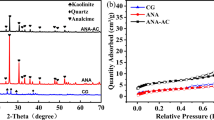Abstract
In-situ coupling of adsorptive desulfurization and biodesulfurization is a new desulfurization technology for fossil oil. It has the merits of high-selectivity of biodesulfurization and high-rate of adsorptive desulfurization. It is carried out by assembling nano-adsorbents onto surfaces of microbial cells. In this work, In-situ coupling desulfurization technology of widely used desulfurization adsorbents of γ-Al2O3, Na-Y molecular sieves, and active carbon with Pseudomonas delafieldii R-8 were studied. Results show that Na-Y molecular sieves restrain the activity of R-8 cells and active carbon cannot desorb the substrate dibenzothiophene (DBT). Thus, they are not applicable to in-situ coupling desulfurization technology. Gamma-Al2O3 can adsorb DBT from oil phase quickly, and then desorb it and transfer it to R-8 cells for biodegradation, thus increasing desulfurization rate. It is also found that nano-sized γ-Al2O3 increases desulfurization rate more than regular-sized γ-Al2O3. Therefore, nano-γ-Al2O3 is regarded as the better adsorbent for this in-situ coupling desulfurization technology.
Similar content being viewed by others
References
EPA. Heavy-duty engine and vehicle standards and highway diesel fuel sulfur control requirements. EPA420-F-00-057. 2000
Yuan Q T. Speeding up the progress of petrochemical technologies for sustainable development of petrochemical industries in China. Acta Petrolei Sinica (Petroleum Processing Section) (in Chinese), 2005, 21(3): 1–6
Takashi O, Yoshikazu I. Microbial desulfurization of organic sulfur compounds in petroleum. Biosci Biotechnol Biochem, 1999, 63(1): 1–9
Folsom B R, Schieche D R, Digrazia P M, Werner J, Palmer S. Microbial desulfurization of alkylated dibenzothiophenes from a hydrodesulfurized middle distillate by rhodococcus erythropolis I-19. Appl Environ Microbiol, 1999, 65(11): 4967–4972
Kobayashi M, Horiuchi K, Yoshikawa O, Hirasawa K, Ishii Y, Fujino K, Sugiyama H, Maruhashi K. Kinetic analysis of microbial desulfurization of model and light gas oils containing multiple alkyl dibenzothiophenes. Biosci Biotechnol Biochem, 2001, 65(2): 298–304
Lun S Y. Environmental Bioengineering (in Chinese). Beijing: Chemical Industry Press, 2002. 145–151
Song C S. An overview of new approaches to deep desulfurization for ultra-clean gasoline, diesel fuel and jet fuel. Catal Today, 2003, 86: 211–263
Hernández-Maldonado A J, Yang R T. Desulfurization of liquid fuels by adsorption via π-complexation with Cu(I)-Y and Ag-Y zeolites. Ind Eng Chem Res, 2003, 42(1): 123–129
Shan G B, Zhang H, Liu H, Xing J. π-Complexation studied by fluorescence technique: Application in desulfurization of petroleum product using magnetic π-complexation sorbents. Sep Sci Technol, 2005, 40(14): 2987–2999
Tian F, Wu, Jiang Z, Liang C, Yang Y, Ying P, Sun X, Cai T, Li C. The study of thiophene adsorption onto La(III)-exchanged zeolite NaY by FT-IR spectroscopy. J Colloid Interf Sci, 2006, 301: 395–401
Shan G B, Zhang H, Cai W, Xing J, Liu H. Improvement of biodesulfurization rate by assembling nanosorbents on the surfaces of microbial cells. Biophys J, 2005, 89(6): L58–L60
Vikas B, Anand G, Subrata K, Catherine J M and Ravi F S. Deposition of CTAB terminated nanorods on bacteria to form highly conducting hybrid system. J Am Chem Soc, 2005, 127: 17600–17601
Kim J H, Ma X, Zhou A, Song C. Ultra-deep desulfurization and denitrogenation of diesel fuel by selective adsorption over three different adsorbents: A study on adsorptive selectivity and mechanism. Catal Today, 2006, 111: 74–83
Author information
Authors and Affiliations
Corresponding authors
Additional information
Supported by National Basic Research Program of China (Grant No: 2006CB202507) and National High-tech R&D Program (Grant No: 2006AA02Z209)
Rights and permissions
About this article
Cite this article
Zhang, H., Liu, Q., Li, Y. et al. Selection of adsorbents for in-situ coupling technology of adsorptive desulfurization and biodesulfurization. Sci. China Ser. B-Chem. 51, 69–77 (2008). https://doi.org/10.1007/s11426-007-0118-5
Received:
Accepted:
Issue Date:
DOI: https://doi.org/10.1007/s11426-007-0118-5




